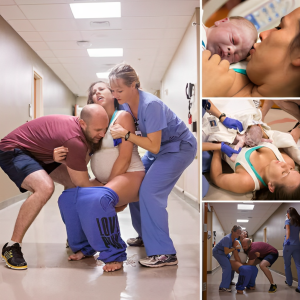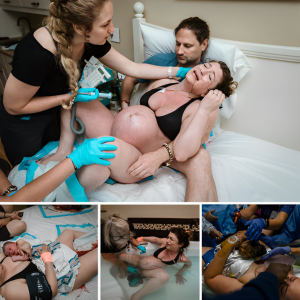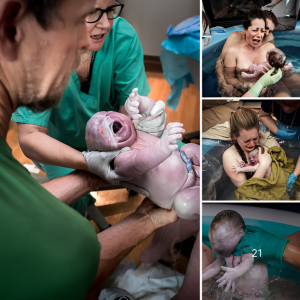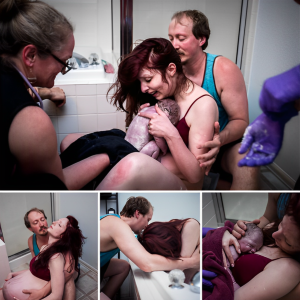I am Tuscarora Bear Clan of Six Nations of the Grand River. I have four beautiful children — Gage, 14, Allister, 6, Avery, who will be 3 in November, and Lillian, who is six months.
I’ve been doing photography for 11 years. I’ve always been creative. I went to culinary school. I was a copywriter, who worked in radio, TV, print and digital. But photography has always been that constant for me. I love capturing those unexpected moments of humanity, whether it’s of clients, friends, family or myself. Capturing those moments, those people and those genuine interactions — that’s so special to me.
I had not captured the births of my children before in photos. But I knew, when my partner Jennifer was pregnant earlier this year, that was our last child. That’s why I wanted to capture Lillian’s birth and have that special moment for me and my family forever.
Because this was such a personal and intimate moment, I thought it would be prudent to ask Jennifer’s permission. She said yes and agreed that such a special moment would be incredible to capture. It was an amazing gift from her to me.

She had been labouring all day in our bedroom. I had made the bed for her and she was just sort of cozied up under the sheets.
It got pretty unbearable around 10 p.m. It was a warm night and the kids were out of the house. They’re curious, and there’s a lot of screaming and blood in childbirth. Plus, we thought it would be distracting for both of us.
This was Jennifer’s first home birth and what an incredible experience it was.
The midwives from the Six Nations birthing centre came to our home. The same midwives had helped to birth our eldest daughter. They were incredible — so helpful, caring, compassionate and loving.
As this was a home birth, there was a lot of anxiety about what could happen or things that could go wrong. We didn’t focus on that, but it sits in the back of your head. But also, I thought about Jennifer’s resilience. This is the second time I’ve seen her labour at home (the first time she delivered at the birthing centre). The strength it takes to go through the process. There was no epidural.
Birth is hard. Birth is dangerous. As a man, I cannot fathom the pain that women go through in this process.

And then the happiness that just floods over everybody in the room when that baby finally comes.
Lillian was born in her amniotic sac, which is really uncommon. When she came out, she was squished up in this filmy sac. It was the craziest thing I’ve ever seen. The midwives were in awe, because it’s a rare occurrence, even for them.
That’s when we brought the other kids back. It was just like this amazing love fest. Allister, our second oldest son, was so happy to meet his new baby sister. Avery was also happy to meet her. She’s only two-and-a-half-years-old, but she understands.

The year Lillian was born was a tumultuous time in my life. My mom had died in February, only a month before our daughter’s birth, after battling cancer for almost five-and-a-half years.
I was devastated by the loss of my mother. I’m an only child and she was my rock. Though we had our disagreements, she was always there for me — no matter how dumb I was or the silly decisions I made. It pains me she could not be there for the birth, because she so badly wanted to see the baby. Not only does she not get to experience meeting her newest grandchild, but my children have lost out on someone who was an inspiring and an amazing presence.
She was such a good grandma — caring, kind and loving. She was hard when she needed to be; she was soft when she needed to be. She had a special relationship with the grandkids. She was a shoulder for them, especially for my eldest son, Gage, because she was that person that he could talk to and rely on. If something went wrong in his life and he was too worried to tell his mom or me, he could go to my mom and express how he felt, free of judgment.
That’s how grandparents should be, they should be open with their grandkids. I have no doubt that she would have been an amazing grandmother to Lillian as well. That’s what pained me the most.

My grandfather and my grandmother were both residential school survivors. So were my great-grandparents, and that intergenerational trauma worked its way down the line. Hard.
As a kid, in retrospect, there are some things about my mom that I resent. My grandfather was an alcoholic when he was younger. He wasn’t a good man. He was 21 and my grandmother was 17 when they got married. That’s young. My mom came not long after. And she carried that trauma. My two uncles and my mom got strapped and they were abused verbally.
I was lucky, because my mom was never like that with me. At the same time, I don’t know if she was ready to be a mother. She was emotional and quick to anger. Her life just didn’t go the way she wanted it to go. She was a single mother. She carried that emotional burden with her and she made some questionable choices during my childhood.
But for the most part, she tried hard to put a stop to that generational trauma.
The next generation, to me, represents hope. I made some questionable decisions in my life and I have really bad coping habits. That’s something I’m working on, because that’s not something I want to pass on to my kids.

I want my kids to have a healthier sense of mental wellbeing. Their generation represents change and hope. It represents a renewal of Indigenous culture. We’ve enrolled Allister in Kawenni:io/Gawęní:yo Private School, a Mohawk and Cayuga immersion school. My daughters will go to that same school when it’s time.
Jen and I have also enrolled in an online Mohawk class. We want to foster an environment for our children where they come from school and see us speaking the language and can express themselves with us in the same language.
It’s been such a journey with them. They’re so bright and are wonderful kids. They’re that next step in healing.
I want [my children] to experience what it really truly means to be an Indigenous person growing up in 2022.– Ian Maracle
We do our best as parents, but I don’t want them to inherit that trauma that I did. I want them to have a healthy sense of self.
Haudenosaunee culture is community oriented. This western style of living — the single-dwelling houses — is not how we lived. We lived in longhouses and communal dwellings. The community helped raise those kids. It was aunts, uncles, friends, grandparents; it was everybody.
That’s what I want them to experience through going to Kawenni:io and bringing them to family events and the tight-knit community that is Six Nations.
I want them to experience what it really truly means to be an Indigenous person growing up in 2022.

There are things in the past that we need to acknowledge and that are important to acknowledge — my grandparents went through it, my great-grandparents went through it. It was a genocide. But we have a bright future ahead of us.
We have survived, and we will not be beaten down. While it still may be in shambles, we are retaining our culture. We are letting it grow and we are handing it down to the next generation after us.
When I was in high school, there were kids that went to the longhouse, but they were laughed at. It was stigmatized in the early 2000s. But I’ve seen an immense change over the past 15 years. The people that laughed at those kids now go to longhouse. They go to ceremony and they’ve come to see the importance and significance of these cultural practices.
We’re a lost people. But we are slowly finding ourselves. And I really, truly feel that the generation after me — my children — will be the ones to really carry the torch of tradition and culture into the future.




